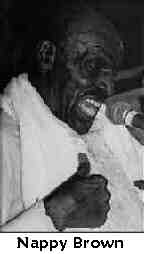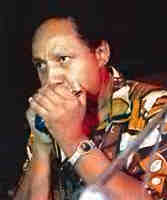
The early Thirties
met blues with a cold shoulder financially. Record sales dropped
and many recording companies went out of business. As the decade
continued, it saw the rise in popularity of collaborative efforts
in the music scene and by its end companies could afford to sent
talent scouts back out in the field looking for new musicians1.
By the end of the 40s, blues musicians had to compete with the
jukebox. Though on record they were blues artists, during live
performances they became any kind of musician the audience called
for. The blues artist had to become as versatile as a jukebox
if he wanted to make money2.
White cover versions
of black songs eased white fans toward black music. Up through
the early to mid 1950s, it was still frowned upon for white teenagers
to listen to black music. Record companies worked around this
attitude by recording covers, songs white artists recorded that
were originally hits for black artists. The Crew Cuts recorded
the first important cover in 1954 with "Sh-Boom," a
song that was originally a hit for the Chords3. Brian
Ward comments in Just My Soul Responding, "nothing
did more than the cover phenomenon to facilitate a mass market
for r&b and extend the opportunities for black artists, writers
and entrepreneurs4." Pat Boone covered Little
Richard's "Tutti Frutti" in 1956 which reached number
18 on the pop best-seller lists. Later that year, Little Richard
put out "Long Tall Sally, " a hit that climbed to number
6 on the lists. However, by the time Boone came out with the cover,
it did not make the best-seller lists. Billboard reported "the
public is beginning to show a decided preference for the original
- regardless of their origin." Radio stations could no longer
afford to play the covers over the originals, so black music performed
by black artists was getting an increasing amount of publicity5.
But, it was these cover versions that served as a passageway for
white Americans to the place where they could openly listen and
dance to black music. Again, the music became common ground to
blacks and whites. It gave them a mutual interest upon which to
build a better relationship. This section delves into the role
parties and dances played by creating a venue where whites and
blacks could come together and interact in an exhilarating atmosphere,
one in which "the rules" could be bent.
Almost as soon as
the slaves arrived, they began forming bands. These bands featured
a variety of instruments including homemade lutes, percussion
instruments, and flutes or fifes. They were also the artistic
force behind the blackface minstrel shows that were soon to become
greatly popular. Experts find evidence of white appreciation for
early black music in the way whites treated those workers who
were musically talented. Robert Palmer, author of Deep Blues,
mentions the Senegambians in particular who were admired for their
musical ability and allowed special privileges on many plantations.
They were granted light housework while slaves from other African
regions were made to complete the harsh fieldwork1.
In the early 19th century, advertisements would point out the
musical talents of the slaves who were for sale knowing that would
put them in higher demand2.
Blues infected its
fans, both black and white, with the craving to dance. One way
blues brought the races in contact with each other was through
mixed dances and parties. Though both blacks and whites were allowed
in the same building, they were not allowed to intermingle. The
dances occurred during a time when Jim Crow laws held a tight
grip on the South. To keep whites and blacks from mixing together
on the dance floor, officials would divide it in  half with a piece of cord or rope. Whites
danced on one side and blacks on the other. As the evening wore
on, the music was able to swallow up the Jim Crow laws, at least
while it was playing and the people were dancing. In a conversation
I had with him in November 1998, Nappy Brown remembered that by
the end of the evening, the white people had torn the ropes down
and crossed over to dance with the blacks. He added that it was
always the whites who instigated the crossover because a black
doing so risked being lynched. Ruth Brown told the same story,
"I'm overjoyed to say that many times the ropes came down,
they'd fall because the music got in the way of attitudes and
feelings and nobody cares who rubbed against each other. Everybody
was having a good time. They didn't care what color your face
was, for a moment…while the music was good6." half with a piece of cord or rope. Whites
danced on one side and blacks on the other. As the evening wore
on, the music was able to swallow up the Jim Crow laws, at least
while it was playing and the people were dancing. In a conversation
I had with him in November 1998, Nappy Brown remembered that by
the end of the evening, the white people had torn the ropes down
and crossed over to dance with the blacks. He added that it was
always the whites who instigated the crossover because a black
doing so risked being lynched. Ruth Brown told the same story,
"I'm overjoyed to say that many times the ropes came down,
they'd fall because the music got in the way of attitudes and
feelings and nobody cares who rubbed against each other. Everybody
was having a good time. They didn't care what color your face
was, for a moment…while the music was good6."
 Billy Boy Arnold recounts: Billy Boy Arnold recounts:
I saw those barriers
breaking down when I was on a tour with Johnny Guitar Watson
and Fats Domino in 1957. We were all down in Louisiana and Texas,
and Fats was drawing as many white people as blacks. They had
a partition and the white kids had to be on this side and black
kids were over here dancing and having a good time. The white
kids could only look and they wanted to dance and enjoy the music
- so they tore the partition down. The die-hard racists were
saying, what the hell's happening? I knew then that things couldn't
stay the same way they had always been7.
1. Russell,
24-25
2. Davis, 143-144
3. Bane, 98
4. Ward, 44
5. Ward, 46-50
6. That Rhythm, Those Blues
7. Trynka, 123
 Back to top Back to top
|
